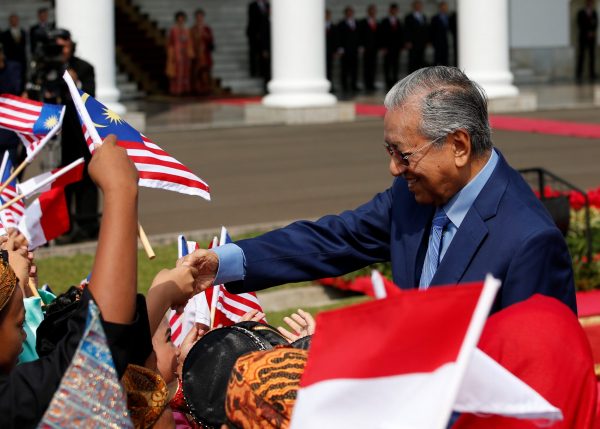Indian Prime Minister Narendra Modi called on Mahathir not too long after the latter assumed office. The meeting was significant in so far as Modi is keen on ‘Acting East’ and forging stronger ties with ASEAN. With Mahathir at the helm, Modi may well have an active and influential partner in the region. India is likely to be an economic powerhouse in the coming decade or two, and any long-term economic architecture in the region will have to take this reality into account.
Does Mahathir run the risk of disrupting Malaysia’s economic relations with China by engaging with other partners? Not quite, but he does want to tilt the balance.
Mahathir is not questioning China’s intention to build friendly, harmonious and prosperous relations with the region or with Malaysia. But he is adding a dose of reality to some of the more questionable investment agreements that Malaysia has entered into with China and wants these deals to be reviewed. Mahathir has said that ‘we will be friendly to China but we don’t want to be indebted to China’.
The Prime Minister is keen to do business with anyone who means business, provided there are no hidden caveats and Malaysia is not compromised. If there was any question of wanting to cut off China, Mahathir would not have met with Chinese entrepreneur Jack Ma.
This brings us to Mahathir’s meeting with a second foreign leader, Japanese Prime Minister Shinzo Abe. Why did Mahathir choose to go to Japan on his first official overseas trip soon after he came to power?
Mahathir probably sees value in reviving his ‘Look East’ policy, which he pursued while prime minister in the 1980s, perhaps in a different form and for slightly different reasons. There is an element of nostalgia, to be sure.
The previous Najib administration did not treat the notion of equidistance from global superpowers with the sensitivity it deserved. There was a tumbling over to China coupled with a reticence to engage with Japan, at least with nothing of the enthusiasm that Tokyo enjoyed during Mahathir’s days.
Mahathir has always believed in maintaining equidistance from other powers, preferring to work with the larger economies as equals. Mahathir would, by logical extension, be willing to cooperate with China’s Belt and Road Initiative as long as the partnership is fair and without Beijing using Malaysia as its playground. In that respect, reaffirming Malaysia’s long friendship with Japan is a reassertion of Mahathir’s pragmatic approach to geo-economic policy.
But equidistance is not possible without the existence of something like the Non-Aligned Movement. In lieu of that, Mahathir will likely pursue equidistance through a more integrated ASEAN in partnership with other countries such as the United States, China, Japan, South Korea, India and the Central Asian states. This would be a revival of his East Asian Economic Caucus (EAEC) concept.
A close-knit ASEAN, through the EAEC, would be able to give countries such as Malaysia more access to foreign markets without having to pay an onerous price for doing so. It would allow countries like India to trade and invest in Southeast Asia or other places while being able to show their home constituencies that they can make gains without paying for them with tough commitments.
Strengthening ASEAN’s economic cohesion and including other powers through the EAEC would mean that neither the United States nor China could dominate Malaysia’s foreign policy. Malaysia would not have to choose between aligning with either power. Mahathir’s discussion with Jack Ma after his India and Japan meetings shows the Prime Minister’s pragmatism — more than being caught up in great power politics, Mahathir wants to push ahead with attracting no-strings-attached investment, be it from China, India or any other part of the world.
Mahathir understands that trade and investment are Malaysia’s lifeblood. Improving Malaysia’s networks with the rest of the world’s markets must take top priority to foster better trade and investment connections.
Mahathir’s meetings with Modi and Abe will set in motion a couple of initiatives. Malaysia will return to its default position of maintaining equidistance between superpowers. Japan will not feel it is being edged out of Malaysia’s investment landscape. Malaysia will stand for a free and unaligned ASEAN, with Mahathir leading a campaign for a new trade architecture that might be more palatable to Southeast Asian countries and which will minimise the conflicting demands of China, the United States and India.
Of course, the EAEC idea will have its share of detractors and non-adherents. Much as Mahathir has a tough job setting domestic affairs right now, he has the no less difficult task of realigning the country’s geo-economic policy.
Shankaran Nambiar is a senior research fellow at the Malaysian Institute of Economic Research.
A version of this article originally appeared here in The Sun Daily.

